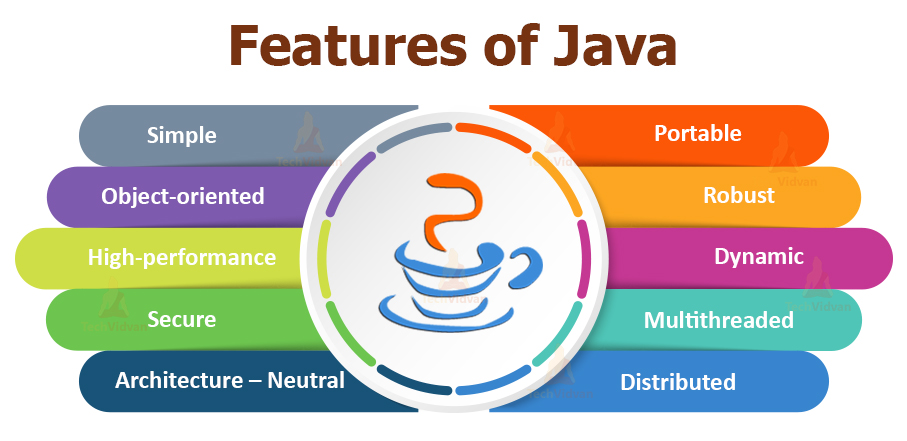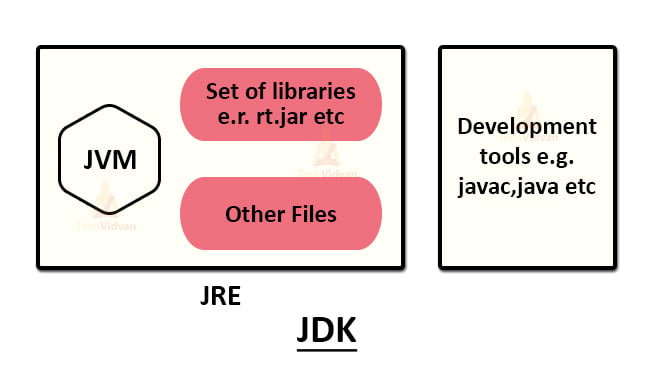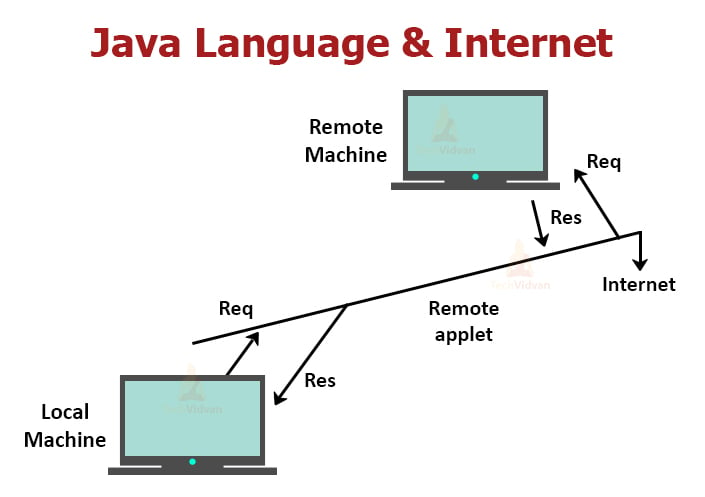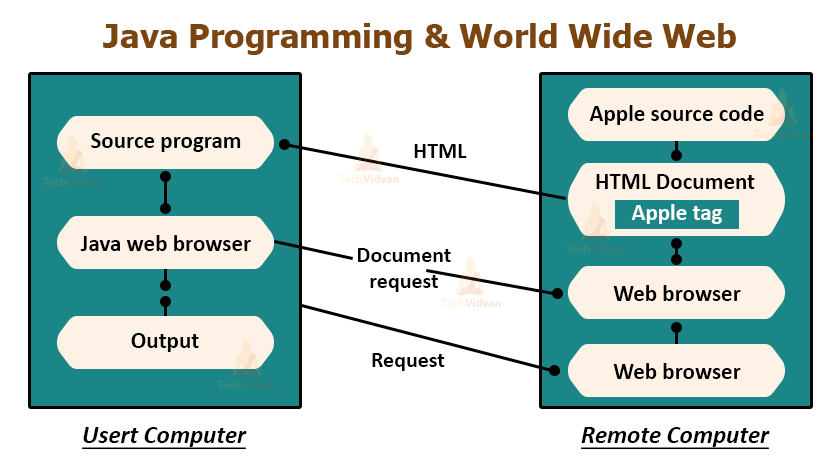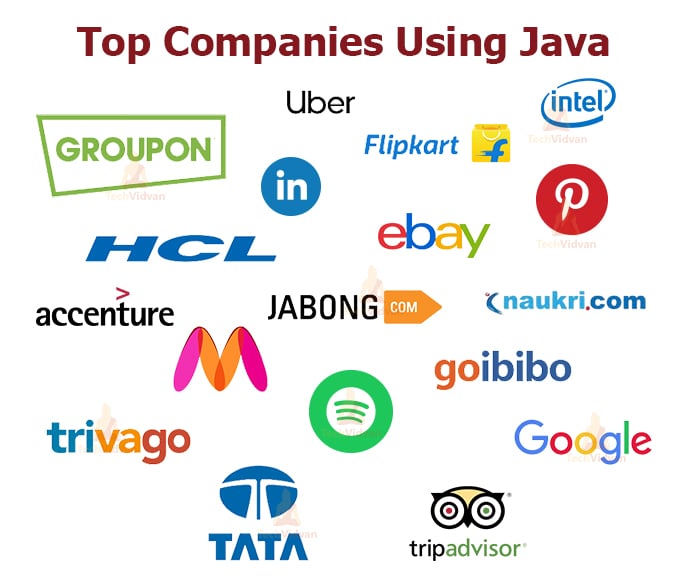Java Tutorial – A Complete Comprehensive Guide for Java Beginners
Do you want to learn the Java programming language and become an expert in Java? And are you still looking for the best Java tutorial?
Techvidvan Java tutorial is specially designed for beginners as well as Java professionals to learn Java programming language from scratch. There will be all the information on Java programming language in this tutorial.
Let’s have a quick look at what we will learn in this Java tutorial. So let us start the tutorial.
Introduction to Java
Java is a general-purpose and object-oriented programming language developed for the distributed environment and software development for consumer electronic devices such as TVs, VCRs, toasters, etc.
Java Programming Language is a platform-independent language, which means there is no limitation to any particular hardware or operating system. It provides users the facility to ‘write once, run anywhere’.
Many operating systems such as Sun Solaris, RedHat, Windows, etc., support Java.
Java is a concurrent, class-based, and object-oriented language. It is freely accessible, and we can run it on all the platforms or the operating systems. Java is simple and easy to learn.
If we want to print “HelloWorld!”, we would type:
Java Hello World Example
public class HelloWorld {
public static void main(String[] args) {
System.out.println("HelloWorld!");
}
}
Features of Java
According to the TIOBE index, the rank of Java constantly remains in the top 2 languages because of its robust and security features. Let us discuss the features of Java that make it so popular among all the programming languages.
Following are some of the Java features that make it so popular in the programming world:
1. Simple
Java is a simplified version of the C++ language, and therefore, it is familiar also. Moreover, it eliminates all redundant and unreliable code. There is no support of pointers, preprocessor header files, operator overloading, and multiple inheritances in Java. This makes Java easier as compared to C++.
2. Object-oriented
Java is an object-oriented language and mainly focuses on objects rather than processes. Java follows the Object-Oriented Programming (OOP) concept like:
- Objects
- Classes
- Inheritance
- Encapsulation / Data hiding
- Abstraction
- Polymorphism
Note- Java is not a pure object-oriented language as it allows the use of primitive data types.
3. Platform-independent
Java is a platform-independent language as the source code of Java can run on multiple operating systems. Java programs can run on any machine or the operating system that does not need any special software installed.
Although the JVM needs to be present in the machine. Java code compiles into bytecode(.class file), which is platform-independent. We can run this bytecode on Windows, Linux, Mac OS, etc.
4. Portable
Java is portable because Java code is executable on all the major platforms. Once we compile Java source code to bytecode, we can use it in any Java-supported platform without modification, unlike other languages that require compiling the code for each platform.
Java is portable because we can carry bytecode over to any other platform it runs on.
5. Robust
The following features make Java robust and powerful:
- There is no use of explicit pointers in Java.
- Java provides a strong memory management
- It supports Automatic garbage collection, so there is no need to delete the unreferenced objects manually.
- Java also provides exception handling and type-checking mechanisms.
6. Secure
Java is a secure language because of the following reasons:
- Java does not support pointers that make Java robust and secure.
- All Java programs run inside a virtual machine sandbox.
- The Java Runtime Environment(JRE) has a classloader that dynamically loads the classes into the Java Virtual Machine.
- The Bytecode Verifier of Java inspects the parts of code for checking the illegal code that can bypass access.
- The Security Manager of Java decides what resources to allot to a class. Such access includes reading and writing into files.
- Java also helps us develop virus-free systems.
7. Multithreaded and Interactive
Java is a multithreaded language that means it can handle different tasks simultaneously. Java supports multithreaded programs, in which there is no need to wait for one task to finish for another to start.
This feature of Java significantly improves the interactive performance of graphical applications.
History of Java
Java first appeared in the year 1995 as Oak. They also decided to call this language the project Green, before it could find its popularity as Java by finding its roots in coffee, which in turn is attributed to Java- an island in Indonesia.
- The first version 1.0 of Java came in 1996 when Sun Microsystems promised the principle of WORA (Write Once, Run Anywhere) property.
- Then Java 2 (J2SE 1.2) was introduced in December 1998-1999. J2EE(Java Enterprise Editions) was for enterprise applications.
- In 2006, Sun renamed new J2 versions as Java EE, Java ME, and Java SE.
- September 2018 marked the release of Java SE 11 (LTS).
- March 2019 marked the release of Java SE 12 (LTS).
- On September 10th, 2019, Java SE 13 was released.
- Java SE 14 came in March 2020, which is the latest version of Java.
Java Architecture – Java Environment
Now, we will learn the architecture of Java and its main components like JRE, JVM, and JDK. The following diagram shows the architecture of Java:
1. JVM (Java Virtual Machine)
Java Virtual Machine(JVM) provides a runtime environment in which bytecode executes. Java Virtual Machine is platform-dependent. The JVM performs the following tasks:
- Loading the code
- Verifying the code
- Executing the code
- Providing a runtime environment
2. JRE (Java Runtime Environment)
JRE is a collection of tools that allow the development of applications and provide a runtime environment to run Java programs. JVM is a part of JRE. JRE is also platform-dependent.
JRE facilitates the execution of Java programs and comprises JVM, Runtime class libraries, User interface toolkits, Deployment technologies, Java plugin, etc.
3. JDK (Java Development Kit)
Java Development Kit is a kit that provides the environment to develop and execute a Java program. JDK includes development tools to provide an environment to develop Java programs.
It also contains JRE that runs your Java code. JDK also contains other resources like the interpreter/loader, compiler (javac), an archiver (jar), and a documentation generator (Javadoc). These components together help you to build Java programs.
Java Development Kit includes-
- appletviewer (for viewing Java applets)
- javac (Java compiler)
- java (Java interpreter)
- javap (Java disassembler)
- javah (for C header files)
- javadoc (for creating HTML files)
- jdb (Java debugger)
Proceeding ahead in this java tutorial, let us see advantages and limitations of java.
Advantages of Java
- It is a platform-independent language because we can run Java code on any machine without any special software.
- It is an object-oriented language because of its classes and objects. Object-oriented programming increases the ease of code development and increases efficiency.
- It is a secure language, and the reason behind being secure is pointers, Java does not use pointers.
- It supports multithreading; we can execute many programs simultaneously.
- Java is a robust language as it has many features like automatic garbage collection, no use of explicit pointers, exception handling, etc.
- Java is a high-level programming language that makes it easy to learn and understand.
- It provides efficient memory management.
Disadvantages of Java
- Java is a high-level language. Therefore Java must deal with the compilation and abstraction levels of a virtual machine.
- Java exhibits poor performance because of the garbage collector, wrong caching configuration, and deadlocks, among processes.
- Java has very few GUI(Graphical User Interface) builders like Swing, SWT, JSF, and JavaFX.
- We could end up writing long, complicated code if we try to carry out a simple set of activities. This affects the readability of code.
Difference Between C++ and Java
The main difference between C++ and Java is that Java is an Object-oriented language, while C++ just adds an object-oriented feature to C.
Let’s see what makes Java different from C++:
- No support for operator overloading in Java as in C++.
- Java does not provide template classes as in C++.
- Java does not support explicit pointers, but C++ supports.
- There is no support for global variables in Java as in C++.
- Java uses a finalize () function and C++ uses destructor function.
- There are no header files in Java as in C++.
- Java does not support “goto” statements, unique C++.
- C++ supports multiple inheritances through classes, but Java supports the same through interfaces.
- Java does not support “call-by-reference”; it only supports “call-by-value.”
- There is no support for structures and unions in Java, as in C++.
- Java does not support the “virtual” keyword.
Let’s compare a hello world program in C++ and Java.
Example of C++ Programming Language-
#include <iostream>
using namespace std;
int main()
{
cout << "HelloWorld!";
return 0;
}
Example of Java Programming Language-
public class Hello {
public static void main(String[] args) {
System.out.println("Hello, World!");
}
}
Java Language and the Internet
Now, we will discuss how the Internet and Java are related to each other. The diagram below shows the relationship between Java and the Internet.
Java Tutorial – Java Language and Internet
Java is often called the Internet language as HotJava was the first application program in Java. HotJava is a Web browser that runs applets on the Internet.
Internet users can create applets using Java and run them locally using HotJava. Java applets make the Internet a true extension of the storage system on local computers.
Java Programming and World Wide Web
Do you know how Java and the World Wide Web(WWW) are related? World Wide Web is an information system where any information or file has Uniform Resource Locators (URLs), and hypertext links interlink. We can access WWW with the help of the Internet.
The Internet and Java both had the same philosophy, and therefore they were incorporated with each other easily. It was possible only because of Java by providing features like graphics, animation, games, and a wide range of special effects in WWW.
Java Tutorial for beginners – Java with WWW
Java uses Applets to communicate with any web page. The steps involved are –
1. The user sends requests for a hyperlink document to a web server of the remote computer.
2. The hyperlink document contains the applet tag that identifies the applet.
3. The Java source code file compiles the bytecode for that applet and transfers it to the user’s computer.
4. The browser enabled by Java programming interprets the bytecode and provides the output to the user.
Java Support Systems
The operations of Java and Java-enabled browsers on the Internet requires a variety of support systems, like,
- Internet Connection
- Web server
- Web Browser
- HTML(HyperText Markup Language) which is a language for creating hypertext for the web.
- APPLET tag
- Java code
- Bytecode
- Proxy Server that acts as an intermediate server between the client workstation and the original server.
- Mail Server
Applications of Java Programming
Java is a widely-used language, and there are many uses of Java. The following are some of the application areas that use Java:
1. Desktop applications
2. Web applications
3. Mobile applications (Android)
4. Cloud computing
5. Enterprise applications
6. Cryptography
7. Smart cards
8. Computer games
9. Web servers and application servers
10. Scientific applications
11. Operating Systems
12. Embedded systems
13. Real-time software
Java Platform Editions
Let us now discuss the editions Java platform:
1. Java ME (Micro Edition – J2ME)
Java Micro Edition is useful for developing small devices like mobile phones. The Java Micro Edition(ME) API is a subset of the Java Standard Edition(SE) API.
2. Java SE (Standard Edition – J2SE)
The Standard Edition of Java(SE) holds the core functionality of Java. It includes everything from basic types and objects to high-level classes for GUI, database access, networking, and security, etc.
3. Java EE (Enterprise Edition – J2EE)
Java Enterprise Edition builds on top of Java SE. It provides an API and runtime environment for the development and running of large-scale and secure network applications.
4. Java Card
Java Card edition lets us build smart cards using Java.
Top Companies Using Java
When we say that Java is an immensely popular language, we are not merely talking about learners or developers. The following big companies use Java to build or improve their products and services:
Conclusion
Java is the king of all the programming languages. We can see Java holds the first position in the TIOBE index for the last two years. Java is useful in developing applications, but we can also use Java in Big Data, networking, Data Science, etc.
Its outstanding features make it evergreen and popular to learn and build a career in it.
In this Java tutorial, we briefly discussed the Java programming language. We discussed its features, advantages, and disadvantages, and also learned the comparison of Java with C++. We have also learned about its applications and the top companies that are using Java.

